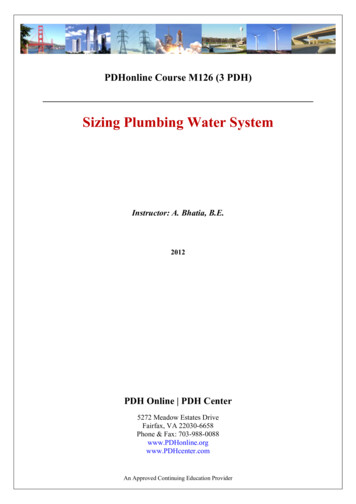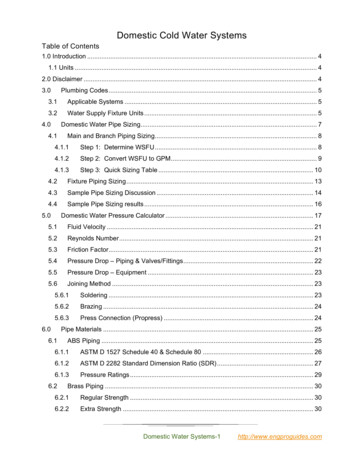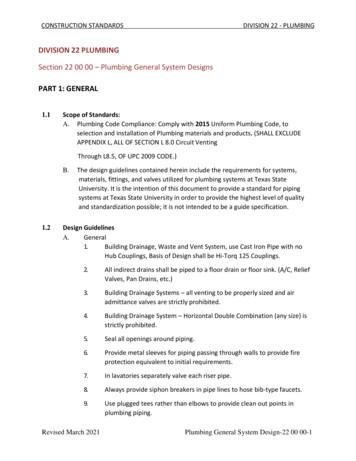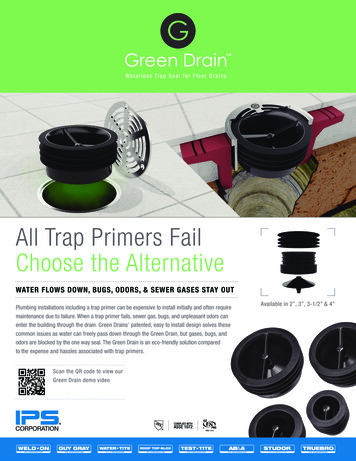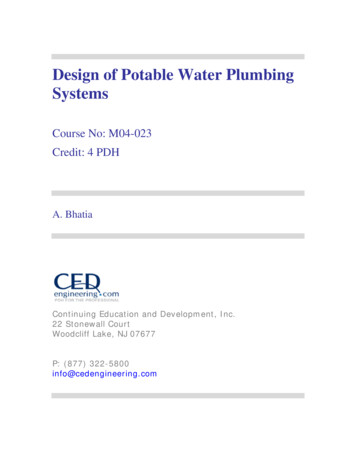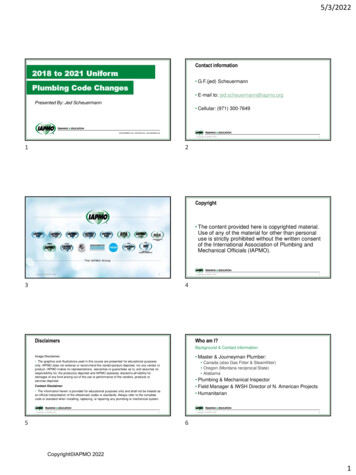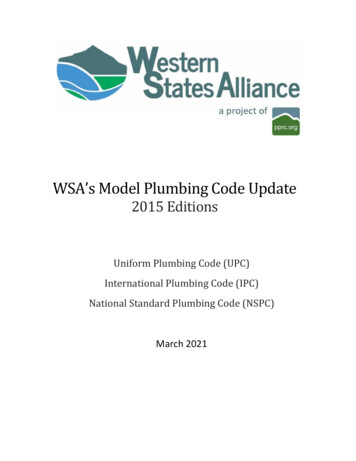
Transcription
WSA’s Model Plumbing Code Update2015 EditionsUniform Plumbing Code (UPC)International Plumbing Code (IPC)National Standard Plumbing Code (NSPC)March 2021
WSA’s Model Plumbing Code Update 2015 Editions03/03/2021Table of ContentsAcronyms, Terms and Definitions . 3Model Plumbing Codes . 6Where the Codes are Adopted . 6Model Code Digests . 7Uniform Plumbing Code – 2015 . 7HGIs and GRDs in UPC . 7GGIs in UPC . 9FOG Disposal Systems . 11International Plumbing Code – 2015. 11HGIs, GRDs, and FOG Disposal Systems in IPC . 11GGIs in IPC. 12National Standard Plumbing Code – 2015 . 12HGIs and GRDs in NSPC . 12GGIs in NSPC . 13Page 2
WSA’s Model Plumbing Code Update 2015 Editions03/03/2021Acronyms, Terms and DefinitionsA2LA: American Association of Lab Accreditation; provides laboratory testing and certificationaccreditation services.Air Break: A piping arrangement in which a drain from a fixture, appliance ordevice discharges indirectly into another fixture, receptacle or interceptor ata point below the flood level rim and above the trap seal.Air Gap: The unobstructed vertical distance through the free atmospherebetween the outlet of the waste pipe and the flood level rim of the receptacleinto which the waste pipe is discharging.ANSI: American National Standards Institute; ensures an open consensus standardsdevelopment process.ANAB: ANSI-ASQ National Accreditation Board; provides laboratory testing and certificationaccreditation services.ASME: American Society of Mechanical Engineers; promotes the art, science & practice ofmultidisciplinary engineering and allied sciences around the globe. Previously developed,administered and published ASME A112.14.3, A112.14.4, and A112.14.6 for grease interceptors– transferred joint ownership of all three standards to CSA/ICC in 2017.ASPE: American Society of Plumbing Engineers; an international organization for professionalsskilled in the design, specification and inspection of plumbing systems. Publishes the PlumbingEngineering Design Handbook series in four volumes.CSA: Canadian Standards Association; a global provider of testing, inspection and certificationservices for products from a wide range of market sectors, a leader in safety and environmentalcertification for Canada and the US, and one of the largest standards developmentorganizations in North America.CSO: Combined Sewer Overflow; a backup in a sewer system designed to carry both sanitarywaste and storm water to a POTW for treatment.DFU: Drainage Fixture Unit; a measure of the probable intermittent discharge into the drainagesystem by various types of plumbing fixtures. The value assigned to any fixture depends on itsvolume rate of drainage discharge, on the time duration of a single drainage operation and onthe average time between successive operations.Effluent: Wastewater discharged to a private or public sewer system.FC or FCD: Flow control or flow control device. May be vented external or integral (built-in)types.Flow Rate: A measurement of the volume of a liquid over time. Typically identified as gallonsper-minute in drainage waste systems.Page 3
WSA’s Model Plumbing Code Update 2015 Editions03/03/2021FOG Control Device: Developing terminology used as an alternative generic description forgrease interceptors found in certain FOG ordinances, i.e. Miami-Dade County.FOG: Fats, Oils and Grease – Organic polar compounds derived from animal and/or plantsources that contain multiple carbon chain triglyceride molecules. FOG normally refers to thebyproduct of preparing and cooking food.FOG disposal system: A grease interceptor that reduces non-petroleum fats, oils and grease ineffluent by separation, mass and volume reduction.FSE: Food Service Establishment; any building, vehicle, place, or structure, or any room ordivision in a building, vehicle, place, or structure where food is prepared, served, or sold forimmediate consumption on or in the vicinity of the premises; called for or taken out bycustomers; or prepared prior to being delivered to another location for consumption.GPM: Gallon per minute; a calculation of flow by volume.GGI: Gravity Grease Interceptor; a plumbing appurtenance or appliance that is installed in asanitary drainage system to intercept non-petroleum FOG from wastewater discharge and isidentified by volume, 30-minute retention time, baffle(s), not less than two-compartments, atotal volume of not less than 300 gallons, and gravity separation.GRD: Grease Removal Device; a hydromechanical grease interceptor that automatically,mechanically removes non-petroleum FOG from the interceptor, the control of which are eitherautomatic or manually initiated.Grease Interceptor: A generic term used in the industry to refer to any of the common types ofdevices including HGIs, GGIs, and GRDs.HGI: Hydromechanical Grease Interceptor; a plumbing appurtenance or appliance that is installedin a sanitary drainage system to intercept nonpetroleum FOG from a wastewater discharge andis identified by flow rate, and separation and retention efficiency. The design incorporates airentrainment, hydromechanical separation, interior baffling, and / or barriers in combination orseparately, and one of the following:A – External flow control, with air intake (vent): directly connectedB – External flow control, without air intake (vent): directly connectedC – Without external flow control, directly ventedD – Without external flow control, indirectly connectedIAPMO: International Association of Plumbing and Mechanical Officials; provides codedevelopment assistance, education, plumbing and mechanical product testing and certification,building product evaluation and a manufacturer-preferred quality assurance program.Develops, administers and publishes the UPC, and IAPMO/ANSI Z1001 and IGC 273 for greaseinterceptors.IAS: International Accreditation Service; a subsidiary of ICC; provides laboratory testing andcertification accreditation services.Page 4
WSA’s Model Plumbing Code Update 2015 Editions03/03/2021ICC: International Code Council; develops model codes and standards used in the design, buildand compliance process to construct safe, sustainable, affordable and resilient structures.Develops, administers and publishes the IPC.Influent: Wastewater that flows into a grease interceptor or pretreatment device.IPC: International Plumbing Code.NAPHCC: National Association of Plumbing Heating and Cooling Contractors; formerlydeveloped, administered and published the NSPC (acquired by IAPMO).NPCC: National Plumbing Code of Canada.NPDES: National Pollution Discharge Elimination System; EPA administered permit programregulating wastewater authorities.NRC: National Research Council; the primary national research and technology organization ofthe Government of Canada, in science and technology research and development.NSF: National Sanitation Foundation (aka NSF International); independently tests, audits,certifies, trains and consults for the food, water, health science, sustainability and consumerproduct sectors. Accredited third-party testing laboratory, certification and listing agency forASME A112.14.3, A112.14.4, CSA B481 Series, and PDI G101. Develops, administers andpublishes NSF SE 15741 for grease interceptors.NSPC: National Standard Plumbing Code.NVLAP: National Voluntary Laboratory Accreditation Program; administered by NationalInstitute of Standards and Technology; provides laboratory testing and certificationaccreditation services.PDI: Plumbing and Drainage Institute; comprised of a group of member organizations, each ofwhich is engaged in the manufacture of products for the plumbing industry. Develops,administers and publishes PDI G101.POTW: Publicly Owned Treatment Works; a term used for a sewage treatment plant that isowned, and usually operated, by a government agency.Pretreatment: the treatment of wastewater by commercial and industrial facilities to removeharmful pollutants before being discharged to a sewer system under the control of a POTW.SSO: Sanitary Sewer Overflow; a backup in a sewer system designed to take separated sanitarywastewater to a POTW for treatment.Stakeholder: A person or party that has an interest in the subject area and can affect or beaffected by the subject area, i.e. wastewater authorities or plumbing code officials.UPC: Uniform Plumbing Code.Velocity: A measurement of the speed a fluid travels in distance over time. Typically identifiedas feet-per-second in drainage waste systems.Page 5
WSA’s Model Plumbing Code Update 2015 Editions03/03/2021Model Plumbing CodesThe purpose of a model code is to provide a set of requirements that represent best practicesfrom experienced professionals that jurisdictions can adopt in whole or in part, rather thanhaving to develop their own. This provides consistency in building design and performance andreduces the cost of constructing and maintaining structures across jurisdictional boundaries.These codes are amended and updated then republished on a three-year cycle and typically haveonly minor amendments or changes in the interim as addendums. There are four model plumbingcodes promulgated in North America: Uniform Plumbing Code (UPC)International Plumbing Code (IPC)National Standard Plumbing Code (NSPC)Where the Codes are AdoptedThe criteria used by both the International Association of Plumbing and Mechanical Officials(IAPMO) and the International Code Council (ICC) in determining the number of states in whichthe UPC or IPC are in use or adopted allows both entities to claim some of the same states astheir own. This is made possible because, while some states do not have statewide adoption ofcodes, both IAPMO and ICC will claim that state as their own if even only one jurisdiction withinthe state has adopted their code. Figure 2 illustrates what the map looks like currently.Figure 2: Map showing the primary plumbing code adopted by each state or province.Page 6
WSA’s Model Plumbing Code Update 2015 Editions03/03/2021Model Code DigestsFollowing is a digest of each of the model codes and their respective requirements governinggrease interceptors. Plumbing codes may or may not be superseded by local pretreatmentordinances, policies, or bylaws that govern the discharge of FOG to sanitary sewer collectionsystems. It is always advisable to check with the local wastewater authority to ensure that agrease interceptor that may be suitable for a project according to the plumbing code is alsosuitable according to the wastewater authority.Uniform Plumbing Code – 2015The UPC is a model code developed by IAPMO. The first edition of this code was officially adoptedby the Western Plumbing Officials Association (now IAPMO) in 1945. The code provides thefollowing requirements governing grease interceptors:HGIs and GRDs in UPCHGIs and GRDs shall be tested and rated in accordance with ASME A112.14.3, A112.14.4, CSAB481.1, PDI G101, or PDI G102. An interceptor only needs to be certified to one of thesestandards to be compliant with the code. HGI installation is permitted indoors or outdoors.Dishwashers and food waste disposers are prohibited from discharging into a grease interceptor.Food waste disposers are allowed to discharge to a grease interceptor that is designed to receivefood waste discharges.Sizing for HGIs is determined by either using the pipe diameter of the grease waste pipingconnected to the inlet of the interceptor (pipe diameter sizing) or by the capacity of all theconnected fixtures by volume (fixture volume sizing).TABLE 1014.2.1HYRDROMECHANICAL GREASE INTERCEPTOR SIZING USING GRAVITY FLOW RATES1Pipe Size(inches)Full-Pipe Flow(GPM)2One-minute drainageperiod (GPM)Two-minute drainageperiod tes1For interceptor sizing by fixture capacity see the example below (Example 1014.2.1).21/4 inch per foot based on Manning's formula with friction factor N 0.012.Table 1: UPC Table 1014.2.1Page 7
WSA’s Model Plumbing Code Update 2015 Editions03/03/2021Table 1 (1014.2.1) came originally from PDI G101 and was expanded to include five and six-inchdiameter pipes. While the code provides the option of a one or two-minute drainage period indetermining the minimum flow rate for the specified HGI, it does not provide a publishedexplanation as to when to use one or two minutes. PDI introduced the one-minute/two-minutedrainage periods, explaining that the two-minute drainage time allows a “convenience factor”that can be used in situations where the physical size of a HGI sized for one-minute is too largeto be accommodated. Sizing the HGI for a two-minute drainage period would result in a unit thatwould be half the size and therefore much smaller. However, reducing the size of the unit by halfalso reduces the grease storage capacity available to the FSE, which would double themaintenance frequency. Thus, while a unit sized to a two-minute drainage period is half as big itwill have to be cleaned twice as often.The pipe diameter for a sanitary drainage system is determined by the number of drainage fixtureunits (DFU) for the fixtures connected to the sanitary system. A DFU represents the potentialintermittent flow from a fixture and one DFU is equivalent to one lavatory. The code assigns aDFU value to each kind of fixture routed to the sanitary system and when they are added togethera table is provided in Chapter 7, which is used to determine the diameter of the drainage pipe.The one-minute drainage period is based on the maximum flow-rate that can be discharged in ahorizontal drainage pipe of a given diameter. Drainage waste piping systems are not designed tooperate at 100 percent of the drainage pipe’s capacity. To allow for proper gravity flow a drainagesystem needs air above the wastewater and therefore systems are designed to operate at notmore than 50 percent of the drainage pipe’s capacity at peak flow. The two-minute drainageperiod allows for the selection of a grease interceptor based on the design capacity of thedrainage system instead of the maximum capacity of the system, which reflects real-worldpractices.EXAMPLE 1014.2.1SIZING HYDROMECHANICAL INTERCEPTOR(S) USING FIXTURE CAPACITYStep 1: Determine the flow rate from each fixture.[Length] X [Width] X [Depth] / [231] Gallons X [.75 fill factor] / [Drain Period (1 min or 2 min)]Step 2: Calculate the total load from all fixtues that discharge into the interceptor.FixturesCompartment size24" x 24" x 12"HydrantRated Appliance-Compartments2-Load (gallons)44.93249.9Size of Grease InterceptorOne Minute DrainagePeriod (gpm)50Two-Minute DrainagePeriod (gpm)25Figure 3: UPC Example 1014.2.1Page 8
WSA’s Model Plumbing Code Update 2015 Editions03/03/2021Figure 3 (1014.2.1) illustrates sizing and selecting a HGI by the capacity of the connected fixturesin volume. Multiplying the length times the width times the depth of a sink gives the volume incubic inches. To convert cubic inches into gallons, divide by 231. The fill factor assumes that asink must have room for dishware and will not be filled to more than 75 percent of its totalcapacity. The option of sizing the interceptor to a one or two-minute drainage period is providedas well.Deciding on whether to use a one or two-minute drainage period when using the fixture volumesizing method is not as straight forward as it is with using the pipe diameter sizing method.Fixtures discharge through a tailpiece that is normally 1-1/2 inches in diameter. If the sink volumefor a single compartment sink is 50 gallons, it will not discharge 50 gallons in one minute througha 1-1/2-inch tailpiece since the maximum flow that can discharge through the tailpiece is onlyabout 18 GPM. In the example above, the sink volume is based on a two-compartment sink, eachof which would have a 1-1/2-inch tailpiece and if discharged simultaneously would flow close to40 gallons in one minute.A flow control device helps to ensure that a HGI will not get overwhelmed by the entering flow,whether using a one or two-minute drainage period. It may be perfectly acceptable to use a twominute drainage period if the fixtures are all directly connected to the interceptor.Indirectly connected fixtures such as floor drains and floor sinks, which have an air gap or airbreak, can allow backups to happen in the kitchen from the HGI, particularly when using a twominute drainage period. In the example above, using a two-compartment sink, if bothcompartments discharge simultaneously and the interceptor is sized based on a two-minutedrainage period, while the sinks could discharge at nearly 40 GPM, the HGI will only accept 25GPM and if there is an indirectly connected fixture, that extra flow is going to flood onto thekitchen floor through the indirectly connected fixture. One solution may be to install the flowcontrol upstream of the indirectly connected fixture or flow restrictors on multiple fixtures thatcould discharge simultaneously into the indirectly connected fixture to ensure that the maximumflow discharging to the HGI does not exceed the two-minute flow rate it was sized for.GGIs in UPCGGIs shall comply with IAPMO/ANSI Z1001, which is a design standard that contains noperformance test. Dishwashers shall be permitted to discharge to a GGI. Sizing GGIs shall be byDFU to determine the liquid gallon holding capacity (minimum 500 gallons) according to the Table2 (Table 1014.3.6).TABLE 1014.3.6GRAVITY GREASE INTERCEPTOR SIZINGDrainage Fixture Units(DFU)1,38Interceptor Volume2(gallons)500Page 9
WSA’s Model Plumbing Code Update 2015 001The maximum allowable DFUs plumbed to the kitchen drain lines that will beconnected to the grease interceptor2This size is based on: DFUs, the pipe size from this code; Table 703.2; UsefulTables for flow in half-full pipes (ref: Mohinder Nayyar Piping Handbook, 3rdEdition, 1992). Based on 30-minute retention time (ref: GeorgeTchobanoglous and Metcalf & Eddy. Wastewater Engineering Treatment,Disposal and Reuse, 3rd Ed. 1991 & Ronald Crites and George Tchobanoglous.Small and Decentralized Wastewater Management Systems, 1998). Roundedup to nominal interceptor volume.3Where the flow rate of directly connected fixtures(s) or appliance(s) have noassigned DFU values, the additional grease interceptor volume shall be basedon the known flow rate (GPM) (L/s) multiplied by 30 minutes.Table 2: UPC Table 1014.3.6The calculations used to determine the size of a GGI attempt to use a 30-minute retention timeby limiting the maximum number of DFUs that are assigned to a given liquid volume for a GGI.Where DFUs are not known, the interceptor shall be sized based on the maximum DFUs allowedfor the pipe size connected to the inlet of the interceptor. Table 3 (703.2) provides the maximumDFU’s per pipe diameter.TABLE 703.2 Drainage Piping (abridged)Pipe Size (inches)1-1/41-1/222-1/2345Maximum DFUs, HorizontalDrainage Piping1181435216428Page 10
WSA’s Model Plumbing Code Update 2015 Editions68101203/03/2021720264046808200Table 3: UPC Table 703.2FOG Disposal SystemsFOG Disposal Systems, including components, materials, and equipment necessary for the properfunction of the system, shall be in accordance with ASME A112.14.6. These devices are onsitetreatment systems intended to reduce FOG discharges to a maximum of 100 mg/L. They are tobe sized and installed in accordance with manufacturer’s instructions.International Plumbing Code – 2015The IPC is a model code developed by the International Code Council. The first edition waspublished in 1995 making this the youngest of the model codes. The code provides the followingrequirements governing grease interceptors:HGIs, GRDs, and FOG Disposal Systems in IPCHGIs, FOG Disposal Systems, and GRDs shall be tested and sized in accordance with ASMEA112.14.3, A112.14.4, A112.14.6, CSA B481, PDI G101, or PDI G102. HGIs are permitted to serveas a fixture trap for a single fixture or combination fixture of not more than three compartmentswhen installed per the manufacturer’s installation instructions. Dishwashers (without pre-rinsesinks) must connect to a grease interceptor. Food waste grinders that discharge to a greaseinterceptor must first be routed through a solids interceptor.Table 4: minimum grease capacity requiredPage 11
WSA’s Model Plumbing Code Update 2015 Editions03/03/2021Table 4 (1003.3.4.1) lists the minimum required capacity for grease interceptors at the statedflow rate. This should not be interpreted as a maximum or exact grease capacity required.The sizing contained in ASME A112.14.3, CSA B481.3 and PDI G101 all use both the pipe diameterand fixture volume methods as described under the UPC section for HGIs above.GGIs in IPCGGIs are to be designed, tested and installed in accordance with IAPMO/ANSI Z1001. They mustbe 500 gallons or larger in capacity, and must be sized by peak flow rate to have a 30-minuteretention time. GGIs with FOG Disposal Systems shall be designed and tested in accordance withboth ASME A112.14.6 and IAPMO/ANSI Z1001.National Standard Plumbing Code – 2015The NSPC is a model code developed by the National Association of Plumbing-Heating-CoolingContractors (NAPHCC). The roots of this code go back to 1933 when the National Association ofMaster Plumbers first published the Standard Plumbing Code. That code was supported only until1942 after which, the National Plumbing Code Coordinating Committee’s work led to theadoption of A40.8 as a standard or model plumbing code in 1955. Efforts to revise this new codeultimately failed and in 1971, the NAPHCC published the National Standard Plumbing Code, whichfollowed the format and sequence of A40.8.Note: On June 6, 2017, IAPMO announced that it had acquired ownership of the NSPC,encompassing all previous editions, the upcoming 2018 edition, and all future editions. IAPMOstated that it had no current plans of canceling this plumbing code and that it would be takingover the amendment and publishing process immediately and would continue the code movingforward.The code provides the following requirements governing grease interceptors:HGIs and GRDs in NSPCHGIs shall comply with ASME A112.14.3 or PDI G101, and GRDs shall comply with ASMEA112.14.4. Sizing shall be in accordance to PDI G101, Table 6.2.10 of the code or themanufacturer’s instruction. Where a food waste grinder discharges through a HGI it must berouted first through a solid’s interceptor upstream of the interceptor. A HGI or GRD may serve asa trap for an individual fixture if the developed length of the drain between the fixture and theinterceptor does not exceed four feet horizontally and 30 inches vertically. Dishwashers arepermitted to be routed to an HGI. Sizing must be in accordance with PDI G101 (fixture volume orpipe diameter with a one or two-minute drainage period), Table 6.2.10 in the code, or themanufacturer’s instructions. Table 5 (6.2.10) illustrates the alternate sizing method in the code.Page 12
WSA’s Model Plumbing Code Update 2015 Editions03/03/2021Table 5: Flow rates assigned by Sink Drain Outlet DiameterGGIs in NSPCGGIs shall be sized and designed by a locally registered and licensed design professional.Prefabricated GGIs shall comply with IAPMO/ANSI Z1001. GGIs shall be sized by gallons factoringa 30-minute retention time at half pipe flows per Appendix K in the code, with an extra 25%storage factor for FOG and solids. Food waste grinders and dishwashers may discharge directlyto a GGI.Page 13
National Standard Plumbing Code (NSPC) March 2021 . WSA's Model Plumbing Code Update 2015 Editions 03/03/2021 . Page 2 . Table of Contents . . Uniform Plumbing Code - 2015 . 7 HGIs and GRDs in UPC .
